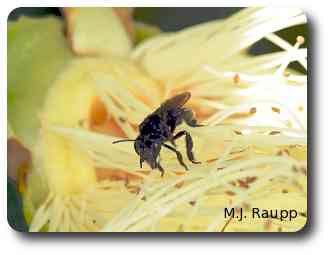A waxy, horn-shapd entrance allows workers to keep out unwanted visitors.
Last week brought the promise of spring to Maryland as above-average temperatures melted piles of snow. In a few short weeks, several species of native bees will shake off winter’s grip and make their first appearance, but this week Bug of the Week returns to the tropical rainforest of Belize where we met army ants, leafcutters, and giant tarantulas in previous episodes. While visiting a rest camp near the Mayan ruins at Xunatunich, we discovered several colonies of stingless bees occupying cinder block walls of a building. Small cracks in the mortar provided perfect entryways to hollow cavities inside the blocks.
Nests
Usually, nests of stingless bees are made inside hollow trees or in cavities below ground, but block walls obviously provided highly suitable nesting sites for bees. In Belize several species of stingless bees live in colonies ranging in size from a few hundred to more than 80,000 workers. Trumpet-shaped entrances lead to brood and honey chambers within the colony. Tubes are constructed of a sticky substance called propolis, a mixture of wax and other materials repellent to ants and other creatures that would love to raid the hive and plunder honey, pollen, and baby bees inside. The nest entrance is also guarded by several workers that watched carefully and mounted a surprising attack when some adventurous humans ventured too close. The assault consisted of dozens of workers flying into faces and pouncing on exposed skin.
Workers gather nectar and pollen from many beautiful tropical plants.
Bees seemed to pay special attention to eyes, noses, and ears. Although they lacked stingers, their annoying bites were very persistent and the intruders gladly vacated the vicinity of the hive. In his book, The Insect Societies, E.O. Wilson describes accounts of stingless bees attacking human intruders. Some species eject an irritating liquid that can “burn” skin. This trick has earned them the local name of cagafogos or “fire defecators” in Brazil. The defense may be potent enough to dissuade very aggressive attackers like army ants from entering nests. Inside the colony, the queen busily fills brood cells with eggs.
Tasks for a worker bee
The life of a worker bee is a predestined regimen of tasks that change as the bee ages. For the first several days of life, worker bees are craftsman shaping and forming the basic building materials of the colony, wax and a wax-like material called cerumen. After a week or so and for several weeks thereafter, workers stock cells with food and have the heady assignment of feeding the queen. About this time, they also begin to produce wax to build the many structures of the nest. Soon workers enter guard duty at the nest entrance. Shortly thereafter, they take on the assignment of collecting nectar and pollen for the hive. Worker bees are common visitors to many kinds of flowering plants in the Belizean jungle. When captured and rolled gently between two fingers, they emit a pleasant floral odor. For centuries ancient Mayans maintained colonies of stingless bees as a source of honey used for sweetening foods and to produce a fermented drink similar to mead.
Unfortunately, with the introduction of Africanized bees and domestic honeybees, the number of colonies of stingless bees has declined dramatically and husbandry of stingless bees is fast becoming a lost art. In addition, fragmentation and loss of natural forests in Central and South America threatens many species of marvelous stingless bees and the tropical plants they evolved to pollinate.
References
We thank the fearless crew of BSCI 279M: Tropical Biology in Belize for providing the inspiration for this Bug of the Week. The fascinating book "The Insect Societies" by E.O. Wilson and “Maya Beekeeping Tradition Fades” by Stefan Lovgren were used as references for this Bug of the Week. To learn more about stingless bees, please visit the following website:
http://news.nationalgeographic.com/news/2005/06/0628_050628_maya_bees.html

